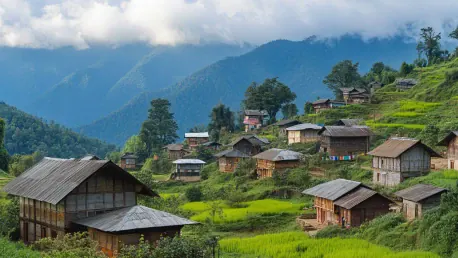In recent years, Northeastern India has emerged as a symbol of sustainable tourism, showing how responsible travel can foster economic growth and preserve cultural heritage. This vast and largely unexplored region, enriched with breathtaking landscapes and rich biodiversity, provides the perfect canvas for sustainable tourism initiatives. Its remote locations, such as Rangapani, Simong, Shergaon, and Tataya, have become focal points for various eco-friendly tourism projects that aim to empower local communities and protect the environment. The third Green Hub x Royal Enfield Responsible Tourism (GH-RE RT) Conclave served as a testament to these efforts, showcasing innovative projects developed by passionate youths who strive to champion sustainability in tourism.
Green Hub x Royal Enfield Responsible Tourism Conclave
The recently concluded third Green Hub x Royal Enfield Responsible Tourism (GH-RE RT) Conclave has become a beacon of hope for sustainable tourism enthusiasts. This event was a melting pot of ideas where young conservationists unveiled their Responsible Tourism action plans, which they had cultivated over six months through an interdisciplinary fellowship. These projects spanned a broad range, from waste-free tourism and agro-tourism initiatives to conservation-based travel experiences, emphasizing the importance of community involvement in achieving sustainability goals. The participants demonstrated the potential of younger generations to lead the charge in protecting the environment while promoting tourism that benefits both visitors and locals.
The conclave also gathered fellowship alumni who shared their success stories, providing invaluable insights into the real-world trials and victories of implementing sustainable tourism models. These narratives served as inspiration for new fellows and underscored the feasibility of creating impactful change through thoughtful and responsible tourism practices. Beyond the presentation of action plans, the event celebrated the diverse cultural tapestry of Northeastern India through interactive exhibitions, traditional performances, and indigenous craft showcases. These activities highlighted the region’s incredible cultural wealth and stressed that preserving these cultural identities is as crucial as environmental conservation in the mission of responsible tourism.
Empowering Communities in Key Ecological Sites
Central to the fellowship program’s success are the key sites chosen for their ecological and cultural importance, where aspiring changemakers can put their models into action. This year’s cycle featured 14 fellows from eight states working on diverse projects at four pivotal sites: Rangapani in Assam, Simong and Shergaon in Arunachal Pradesh, and Tataya in Assam. Each of these locations provided a unique platform for the fellows to develop tourism strategies prioritizing sustainability, community engagement, and conservation. These efforts have begun to set the precedent for responsible tourism, illustrating that travel can be a vehicle for economic and social empowerment for local communities.
Since its inception, the fellowship has connected with youth from 23 communities across eight states, bolstering the region’s conservation efforts through a tourism-driven approach. Each year, the initiative expands, reaching more communities and establishing scalable, community-driven tourism models tailored to ensure economic resilience and environmental sustainability. These models serve as blueprints for other regions facing similar challenges, demonstrating that tourism can be harmonious with nature when guided by thoughtful, responsible practices. The stories emerging from these key sites are testimony to the power of grassroots-level intervention in creating lasting change.
Sustainability and Cultural Preservation
One of the most compelling aspects of the Green Hub x Royal Enfield Responsible Tourism initiative is its comprehensive approach to sustainability, which encompasses both environmental preservation and cultural heritage preservation. The decision to focus on Northeastern India, a region rich in traditions and customs, has paid off immensely. Through its immersive experiences, which include traditional performances, craft-making workshops, and cultural exhibitions, the GH-RE RT initiative emphasizes that responsible tourism is not just about minimizing ecological footprints but also about celebrating and sustaining the indigenous cultures that visitors come to experience.
As the GH-RE RT initiative grows, it has gained increasing momentum, motivating individuals and communities to adopt sustainable travel practices. The movement is more than just a trend; it signifies a lasting shift towards a tourism model that values exploration, preservation, empowerment, and sustainability. By fostering an appreciation for cultural diversity and ecological integrity, the initiative continues to inspire a paradigm where tourism is a catalyst for positive change rather than merely a commercial enterprise. The dual focus on cultural and environmental aspects addresses the wide array of factors necessary for truly responsible and impactful tourism.
Looking Ahead: The Road to Sustainable Tourism
In recent years, Northeastern India has become synonymous with sustainable tourism, demonstrating how responsible travel can spur economic progress and protect cultural heritage. This expansive and largely untapped region, rich in stunning landscapes and diverse ecosystems, offers an ideal setting for sustainable tourism endeavors. Remote locales such as Rangapani, Simong, Shergaon, and Tataya have become central to various eco-friendly tourism projects. These initiatives are designed to empower local communities while safeguarding the environment. The third Green Hub x Royal Enfield Responsible Tourism (GH-RE RT) Conclave highlighted these efforts, showcasing innovative projects initiated by motivated youths who are committed to promoting sustainability in tourism. Through these initiatives, the region serves as a model for integrating eco-conscious travel with community development, setting a benchmark for other regions worldwide. This movement reflects a broader commitment to sustainable practices in the travel industry, aiming for long-term benefits for both people and the planet.









